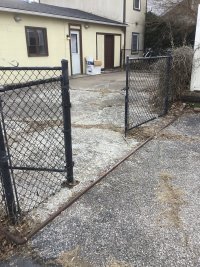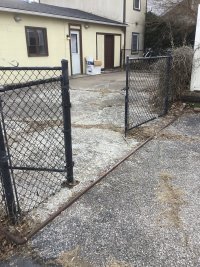-
Welcome to The Building Code Forum
Your premier resource for building code knowledge.
This forum remains free to the public thanks to the generous support of our Sawhorse Members and Corporate Sponsors. Their contributions help keep this community thriving and accessible.
Want enhanced access to expert discussions and exclusive features? Learn more about the benefits here.
Ready to upgrade? Log in and upgrade now.
You are using an out of date browser. It may not display this or other websites correctly.
You should upgrade or use an alternative browser.
You should upgrade or use an alternative browser.
Gas Line Over Driveway
- Thread starter Rebecca Davis
- Start date
klarenbeek
REGISTERED
Wow!
IFGC 404.9 covers outdoor above ground gas piping. It needs to be elevated not less than 3 1/2" above the ground and located where it will be protected from physical damage.
IFGC 404.9 covers outdoor above ground gas piping. It needs to be elevated not less than 3 1/2" above the ground and located where it will be protected from physical damage.
Yikes
SAWHORSE
Your user profile says you are from Indiana, but you didn't say where the property in question is located.
Where was the photograph taken? Is it also in Indiana?
Once you confirm that, we can research the codes adopted by that jurisdiction.
https://up.codes/codes/indiana
Where was the photograph taken? Is it also in Indiana?
Once you confirm that, we can research the codes adopted by that jurisdiction.
https://up.codes/codes/indiana
Msradell
SAWHORSE
Yes, I would ask them to bury it. The other option would be elevating it to meet the IFGC 404.9 mentioned earlier but that would create a definite tripping hazard for pedestrians and would be completely unacceptable for vehicle traffic.
jar546
CBO
It is clearly a violation and there is no way to justify its existence or leave it there.
Shirley where there’s a Will there’s a way.It is clearly a violation and there is no way to justify its existence or leave it there.
Losing the hearts and minds of an aggrieved populace, one gas pipe at a time.
Rebecca Davis
REGISTERED
Yes, the property is in Bloomington Indiana. Thank you!Your user profile says you are from Indiana, but you didn't say where the property in question is located.
Where was the photograph taken? Is it also in Indiana?
Once you confirm that, we can research the codes adopted by that jurisdiction.
https://up.codes/codes/indiana
Yikes
SAWHORSE
Sounds like the original poster is doing a property inspection report. In that case it is her job to point out code compliance issues. It is probably not in the scope to be the fixer of the problem.Shirley where there’s a Will there’s a way.
Losing the hearts and minds of an aggrieved populace, one gas pipe at a time.
Is there any indication of when the gas line might have first been built/ installed?Yes, the property is in Bloomington Indiana. Thank you!
The other posts in this thread are citing current IFGC 404.9, which is applicable to new construction.% But is there any possibility that the applicable code at time of installation would have allowed this condition? If so, it might be “grandfathered” as a pre-existing nonconforming condition.
This is probably a long shot, because I’m guessing that pipe placement has been addressed in the code for a very long time.
Maybe as long as the pipe has there.I’m guessing that pipe placement has been addressed in the code for a very long time.
Yikes
SAWHORSE
Unless there are gas company records or building permit records, the only way to guess at sate of installation is if there is some kind of manufacturing stamp. and even then that only tells you the earliest possible date; that pipe couldn't sat in a warehouse for decades, then been installed in an era when the code would not allow this configuration.Maybe as long as the pipe has there.
If the OP is a private property inspector doing this work under contract, I would simply note that the installation would not comply with current IFGC 404.9 and that further investigation is recommended to determine whether it is legally allowed to remain under current code.
The OP said "rental inspection" Many jurisdictions perform periodic inspections of rental properties to ensure a safe, healthy environment. I have no experience with that. I do have experience with some goofy gas pipes.
While the pipe shown in the picture is a code violation, in the grand scheme of things it hardly rises to a dangerous condition. In as much as the property is a rental, I would have no compunction over writing a correction. Were it just a happy homeowner.... I would leave them smiling.
While the pipe shown in the picture is a code violation, in the grand scheme of things it hardly rises to a dangerous condition. In as much as the property is a rental, I would have no compunction over writing a correction. Were it just a happy homeowner.... I would leave them smiling.
Last edited:
Rebecca Davis
REGISTERED
The building was built in 1950 according to the county. I also wonder if it is enough of a hazard that "grandfathering" would apply.Sounds like the original poster is doing a property inspection report. In that case it is her job to point out code compliance issues. It is probably not in the scope to be the fixer of the problem.
Is there any indication of when the gas line might have first been built/ installed?
The other posts in this thread are citing current IFGC 404.9, which is applicable to new construction.% But is there any possibility that the applicable code at time of installation would have allowed this condition? If so, it might be “grandfathered” as a pre-existing nonconforming condition.
This is probably a long shot, because I’m guessing that pipe placement has been addressed in the code for a very long time.
Yikes
SAWHORSE
1. Do you have any evidence that this particular gas line was installed at the time of original construction, 1950?The building was built in 1950 according to the county. I also wonder if it is enough of a hazard that "grandfathering" would apply.
2. If “yes” to #1, then then what were the adopted codes in Bloomington in 1950? You may have to check at the city clerk’s office to find out.
klarenbeek
REGISTERED
I would disagree. Black iron pipe elevated away from the earth outdoors will get a coating of rust on it and typically that's as far as it will go. Where in contact with the ground is a different matter. Prolonged exposure to wet conditions, contact with whatever minerals or chemicals are in the soil, etc. causing corrosion to the pipe that will continue to deteriorate it. Then there's the matter of the pipe rubbing against the asphalt every time a car drives over it or when the ground heaves in the spring when it thaws. Throw down some ice melt over the winter and it will just accelerate the process.While the pipe shown in the picture is a code violation, in the grand scheme of things it hardly rises to a dangerous condition. In as much as the property is a rental, I would have no compunction over writing a correction. Were it just a happy homeowner.... I would leave them smiling.
I would bet if this has been there for any length of time the bottom of the pipe doesn't look nearly as nice as the top side. This is one of those code provisions where its not an immediate danger shortly after installation, its to prevent a very bad situation 20-30-40 years later. The oldest book I found without actually checking with our plumbing inspector was 1997 and it specifically prohibits unprotected iron pipe on or in the ground, including specifying that galvanized pipe is not considered protected.



